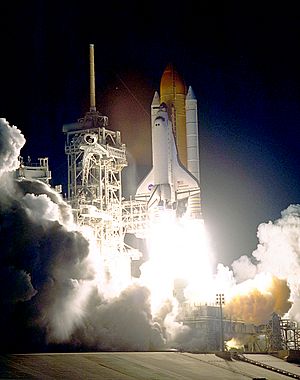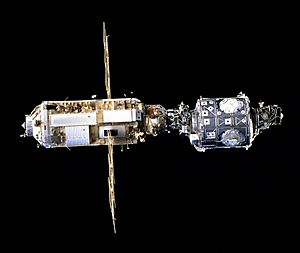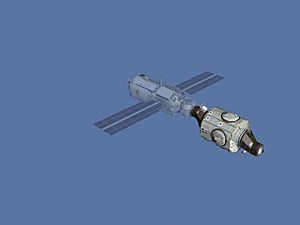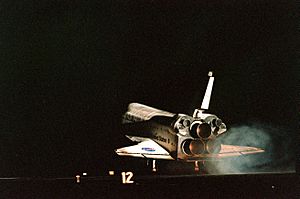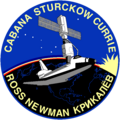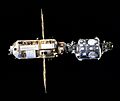STS-88 facts for kids

Endeavour's Canadarm positions Zarya above Unity, immediately prior to mating
|
|
| Mission type | ISS assembly |
|---|---|
| Operator | NASA |
| Mission duration | 11 days, 19 hours, 18 minutes, 47 seconds. |
| Distance travelled | 7,600,000 kilometers (4,700,000 mi) |
| Orbits completed | 186 |
| Spacecraft properties | |
| Spacecraft | Space Shuttle Endeavour |
| Launch mass | 119,715 kilograms (263,927 lb) |
| Landing mass | 90,853 kilograms (200,296 lb) |
| Crew | |
| Crew size | 6 |
| Members |
|
| Start of mission | |
| Launch date | 4 December 1998, 08:35:34 UTC |
| Launch site | Kennedy LC-39A |
| End of mission | |
| Landing date | 16 December 1998, 03:53 UTC |
| Landing site | Kennedy SLF Runway 15 |
| Orbital parameters | |
| Reference system | Geocentric |
| Regime | Low Earth |
| Perigee | 388 kilometres (241 mi) |
| Apogee | 401 kilometres (249 mi) |
| Inclination | 51.6 degrees |
| Period | 92.4 minutes |
| Docking with ISS | |
| Docking port | Zarya forward (via PMA-2, Unity and PMA-1) |
| Docking date | 7 December 1998, 02:07 UTC |
| Undocking date | 13 December 1998, 20:24 UTC |
| Time docked | 6 days, 18 hours 17 minutes |
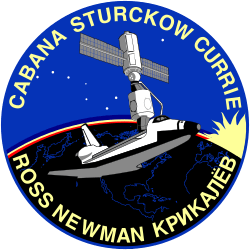  Left to right – Front: Krikalev, Currie; Back: Ross, Cabana, Sturckow, Newman |
|
STS-88 was a very important Space Shuttle mission. It was the first time a Space Shuttle visited the International Space Station (ISS). The mission was flown by the Space Shuttle Endeavour. It carried the first American part of the station, called the Unity node.
This mission lasted seven days. Its main goal was to connect the American-built Unity node to the Zarya module. Zarya was already in space. Astronauts also did three spacewalks to connect power and data cables between Unity and Zarya. The Zarya module was built by Boeing and the Russian Space Agency. It launched into space on a Russian Proton rocket in November 1998. This launch happened from the Baikonur Cosmodrome in Kazakhstan.
Other things carried on the STS-88 mission included a special IMAX camera. There was also a satellite for Argentina called SAC-A. Plus, the MightySat 1 payload and the Space Experiment Module (SEM-07) were on board.
Contents
- Meet the Crew
- Mission Highlights
- Mission Timeline
- Getting Ready for Launch
- Flight Day 1: Launch Day
- Flight Day 2: Preparing for Docking
- Flight Day 3: Unity is Placed
- Flight Day 4: Docking with Zarya
- Flight Day 5: First Spacewalk
- Flight Day 6: Rest and Adjustments
- Flight Day 7: Second Spacewalk
- Flight Day 8: Entering the ISS
- Flight Day 9: Closing Up the Station
- Flight Day 10: Third Spacewalk
- Flight Day 11: Undocking from the ISS
- Flight Day 12: Deploying a Satellite
- Flight Day 13: Landing Day
- Spacewalks (EVAs)
- Wake-up Songs
- Images for kids
- See also
Meet the Crew
The STS-88 mission had six astronauts. They worked together to build the first parts of the International Space Station.
| Position | Astronaut | |
|---|---|---|
| Commander | Fourth and last spaceflight |
|
| Pilot | First spaceflight |
|
| Mission Specialist 1 | Sixth spaceflight |
|
| Mission Specialist 2 | Third spaceflight |
|
| Mission Specialist 3 | Third spaceflight |
|
| Mission Specialist 4 | Fourth spaceflight |
|
Launch Details
The Endeavour Space Shuttle launched on December 4, 1998. It lifted off from Kennedy Space Center's Launch Pad 39A. This was the first time a shuttle flew to the International Space Station. Before launch, the crew got the shuttle ready. They opened the payload bay doors and set up antennas.
Mission Highlights
The Unity node was the first part of the space station brought up by a Space Shuttle. It has two special connectors called Pressurized Mating Adapters (PMAs). One PMA (PMA-1) is always connected to Zarya. The other (PMA-2) is used for the shuttle to dock. Unity also has equipment racks to help with activities in space.
To start building the station, the crew guided Endeavour close to the orbiting Zarya module. Astronaut Nancy Currie used the shuttle's robot arm, called Canadarm, to move Unity. She placed Unity on top of the shuttle's docking system. Commander Robert Cabana then flew Endeavour very close to Zarya. This allowed Nancy Currie to grab Zarya with the robot arm. She then connected Zarya to Unity's PMA.
Once the two parts were connected, astronauts Jerry Ross and James Newman did two spacewalks. They connected power and data cables between Unity, the PMAs, and Zarya. After these spacewalks, Endeavour undocked from the new station. This completed the first step of building the International Space Station.
On December 10, 1998, the astronauts explored the new International Space Station. They entered the Unity and Zarya modules for the first time. They also set up a communication system. This system allowed flight controllers in the U.S. to check on the station. Commander Robert Cabana and Russian Cosmonaut Sergei Krikalev opened the hatch to Unity together. This showed the teamwork involved in building the station.
The rest of the crew followed them inside. They turned on lights and unpacked equipment in the spacious Unity module. Signs inside Unity pointed to where other modules would be connected later.
About an hour later, Cabana and Krikalev opened the hatch to the Russian-built Zarya module. Zarya was the main control center for the station at that time. The whole crew entered Zarya. Cabana and Krikalev celebrated this historic moment. They said opening the hatches marked a new era in space exploration.
Jerry Ross and James Newman immediately started working in Unity. They finished setting up an early communication system. This system allowed controllers in Houston to send commands to Unity. It also let them monitor the station's health. This was a much better communication system than what was available through Russian ground stations. The astronauts also tested the video conferencing part of the system. This system was later used by the first crew to live on the station in November 2000. Newman sent greetings to controllers in Houston. He also greeted astronaut Bill Shepherd, who would command the first crew.
Sergei Krikalev and Nancy Currie replaced a broken part in Zarya. This part controlled how one of the module's six batteries released power. The battery was not working correctly automatically. The new part started working normally soon after it was installed.
The astronauts also unpacked tools and supplies stored in Zarya. They moved these items for future use. These supplies would be used by the shuttle crew visiting in May 1999. They would also be used by Bill Shepherd's crew. The astronauts finished setting up the station for its first operations.
The hatches to Zarya and Unity were closed. Then, Endeavour undocked from the new station. The new space complex was left to orbit Earth without anyone on board.
Mission Timeline
Getting Ready for Launch
On June 23, 1997, the Unity module arrived at the Shuttle Landing Facility. It was brought by a large Air Force cargo plane. On February 1, 1998, Space Shuttle Endeavour was moved to its processing building. On October 15, 1998, Endeavour moved to the Vehicle Assembly Building. Finally, on October 21, 1998, Endeavour was transported to Kennedy Space Center's Launch Pad 39A.
Flight Day 1: Launch Day
The Space Shuttle Endeavour launched at 3:35:34 am EST on December 4, 1998. It lifted off from Kennedy Space Center's Launch Pad 39A. STS-88 was the first shuttle flight to the International Space Station. After launch, the crew opened the shuttle's payload bay doors. They also set up the Ku-Band antenna. The crew prepared for engine firings. These firings would bring Endeavour close enough to grab the Zarya module. At launch, Zarya was 240 miles above Kennedy Space Center. It was on its 222nd orbit since its own launch.
Flight Day 2: Preparing for Docking
On Flight Day 2, the Endeavour crew got ready for docking and spacewalks. Astronaut Nancy Currie took photos of Unity and the shuttle's payload bay. She used the shuttle's robotic arm, Canadarm. Jerry Ross and Jim Newman checked their spacesuits. They also prepared the shuttle's airlock for the spacewalks. Rick Sturckow helped Ross and Newman check their SAFER units. These jet packs would be used if an astronaut floated away during a spacewalk.
Flight Day 3: Unity is Placed
On Flight Day 3, Currie used the Canadarm to grab Unity. She placed it onto the Orbiter Docking System. This happened at 6:45 pm EST. The crew then filled PMA-2 with air. They entered it and put caps over vent valves. This prepared Unity for entry later in the week. Commander Bob Cabana also moved Endeavour to avoid a piece of space junk.
Flight Day 4: Docking with Zarya
On Flight Day 4, Bob Cabana fired Endeavours rockets. This moved the shuttle close to the Zarya module. At 6:47 pm EST, Currie grabbed Zarya with the Canadarm. Later, at 9:07 pm EST, Cabana fired Endeavours jets. This brought the two modules, Unity and Zarya, together.
Flight Day 5: First Spacewalk
Astronauts Jerry Ross and Jim Newman performed a spacewalk. It lasted 7 hours and 21 minutes. They helped activate the Unity node. This was the first module for the U.S. part of the International Space Station. They connected 40 cables and connectors. These cables ran along the 35-ton space station. At 10:49 pm EST, controllers in Houston saw Unity's systems turn on.
Flight Day 6: Rest and Adjustments
On the 6th day, Mission Specialists Jerry Ross and Jim Newman rested after their long spacewalk. Ross, Newman, Nancy Currie, and Sergei Krikalev prepared for the next spacewalk. Commander Bob Cabana and Pilot Rick Sturckow fired Endeavour's jets for 22 minutes. This raised the ISS by about 5.5 miles. The crew also did interviews with news channels.
Flight Day 7: Second Spacewalk
At 3:33 pm EST, Mission Specialists Jerry Ross and Jim Newman began another spacewalk. This one lasted 7 hours and 2 minutes. They continued installing Unity. First, they put two antennas on the outside of Unity. They also removed pins from Unitys four common berthing mechanisms. These pins held things in place during launch. They also installed covers on Unitys data boxes to protect them from sunlight. Finally, Newman freed a backup antenna on the Zarya module.
Flight Day 8: Entering the ISS
Flight Day 8 was a historic day. The International Space Station was opened for the first time in space. At 2:54 pm EST, Commander Bob Cabana and Russian Cosmonaut Sergei Krikalev opened the hatch to the Unity Node. The other crew members started unpacking gear and turning on lights. At 4:12 pm EST, Cabana and Krikalev opened the hatch to Zarya. Jerry Ross and Jim Newman set up a communication system in Unity. Krikalev and Nancy Currie replaced a faulty battery part in Zarya.
Flight Day 9: Closing Up the Station
On Flight Day 9, Pilot Rick Sturckow and Mission Specialist Nancy Currie continued unpacking items in Unity. After turning off the lights, the crew closed the hatches to Zarya and Unity. The crew then got ready for the mission's third and final spacewalk. Endeavour's crew also did interviews with news channels.
Flight Day 10: Third Spacewalk
At 3:33 pm EST, astronauts Jerry Ross and Jim Newman began their third spacewalk. It lasted 6 hours and 59 minutes. They finished installing the Unity Node to Zarya. They stored tools on the side of Unity for future spacewalks. Ross also freed another antenna on Zarya, like the one Newman freed earlier. The spacewalkers also tested new SAFER jet packs. These are used if an astronaut gets separated from the spacecraft. After the spacewalk, Pilot Rick Sturckow removed air from the area between Endeavour and PMA-2. This prepared for the undocking of the two spacecraft.
Flight Day 11: Undocking from the ISS
On Flight Day 11, Space Shuttle Endeavour undocked from the International Space Station. At 3:25 pm EST, Pilot Rick Sturckow backed Endeavour 450 feet away. He then flew the shuttle around the station. This allowed the crew to take pictures of the new space station. At 4:49 pm EST, Sturckow performed a final engine burn. This moved Endeavour away from the station. Later, the crew deployed SAC-A. This was a small satellite for Argentina.
Flight Day 12: Deploying a Satellite
On the last full day in space, the crew deployed a small Air Force satellite called MightySat-1. The crew tested the shuttle's control surfaces and steering jets. These would be used for landing. They also stowed equipment.
Flight Day 13: Landing Day
Flight Day 13 was landing day for Space Shuttle Endeavour and its crew. At 7:07 pm EST, the shuttle's payload bay doors were closed. This prepared the shuttle for re-entry into Earth's atmosphere. Flight Director John Shannon gave the go-ahead for the deorbit burn. This burn happened at 9:46 pm EST. It slowed Endeavour down so it could enter the Earth's atmosphere. At 10:54 pm EST, Endeavour and its crew landed on Kennedy Space Center's Runway 15. Endeavour completed a 4.7 million mile mission. It was the first mission to the International Space Station.
Spacewalks (EVAs)
Three spacewalks were planned and completed during STS-88. These spacewalks were very important for building the International Space Station.
| Spacewalkers | Start (UTC) | End (UTC) | Duration | What They Did | |
|---|---|---|---|---|---|
| EVA 1 | Jerry L. Ross James H. Newman |
7 December 1998 22:10 |
8 December 1998 05:31 |
7 hours, 21 minutes | Started installing the Unity module. |
| EVA 2 | Ross Newman |
9 December 1998 20:33 |
10 December 1998 03:35 |
7 hours, 02 minutes | Continued installing the Unity module. |
| EVA 3 | Ross Newman |
12 December 1998 20:33 |
13 December 1998 03:32 |
6 hours, 59 minutes | Finished installing the Unity module. |
Wake-up Songs
NASA has a tradition of playing music to astronauts. This started during the Gemini program. The first time music was used to wake up a crew was during Apollo 15. Each song is chosen carefully, often by the astronauts' families. The songs usually have a special meaning to an astronaut or relate to their daily tasks.
| Flight Day | Song | Artist | Played for | Links |
|---|---|---|---|---|
| Day 2 | "Get Ready" | The Temptations | WAV, MP3 | |
| Day 3 | "Anchors Aweigh" | Charles A. Zimmermann | WAV | |
| Day 4 | "Over the Rainbow" | Judy Garland | Robert D. Cabana | WAV |
| Day 5 | "Jerry the Rigger" | old Celtic song | Jerry L. Ross | WAV |
| Day 6 | "Streets of Bakersfield" | Dwight Yoakam | Frederick W. Sturckow | WAV |
| Day 7 | "Floating in the Bathtub" | James H. Newman | WAV | |
| Day 8 | "God Bless the U.S.A." | Lee Greenwood | Nancy J. Currie-Gregg | WAV |
| Day 9 | "Trepak" | Pyotr Ilyich Tchaikovsky | Sergei Krikalev | MP3 |
| Day 10 | "Hound Dog" | Elvis Presley | WAV | |
| Day 11 | "Goodnite, Sweetheart, Goodnite" | The Spaniels | WAV | |
| Day 12 | "I Got You (I Feel Good)" | James Brown | "In honor of the good feelings evoked by this successful first International Space Station Assembly mission." | WAV, MP3 |
| Day 13 | "Ride of the Valkyries" | Richard Wagner | WAV |
Images for kids
See also
 In Spanish: STS-88 para niños
In Spanish: STS-88 para niños


